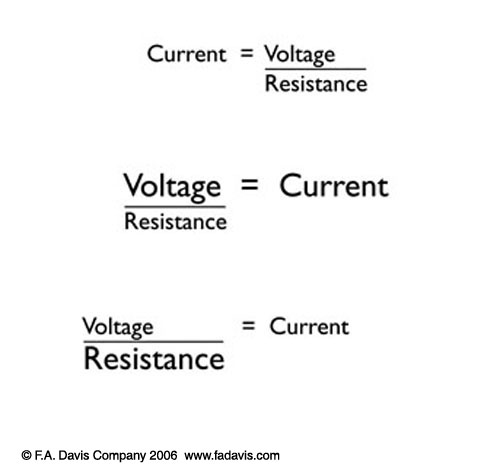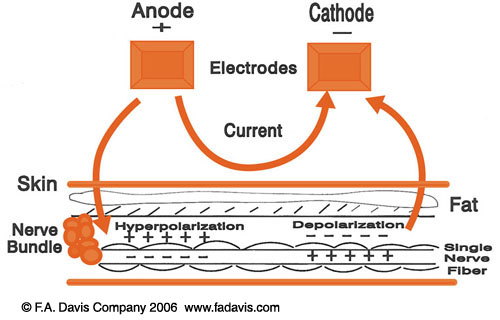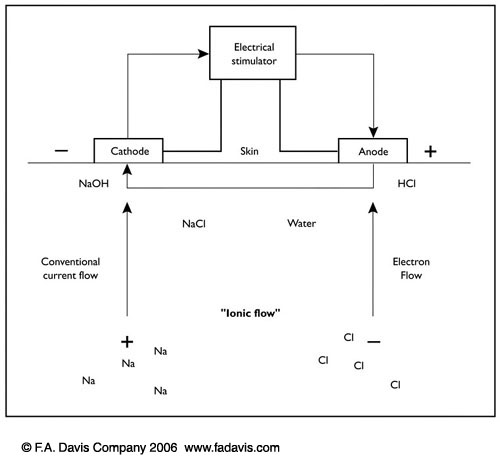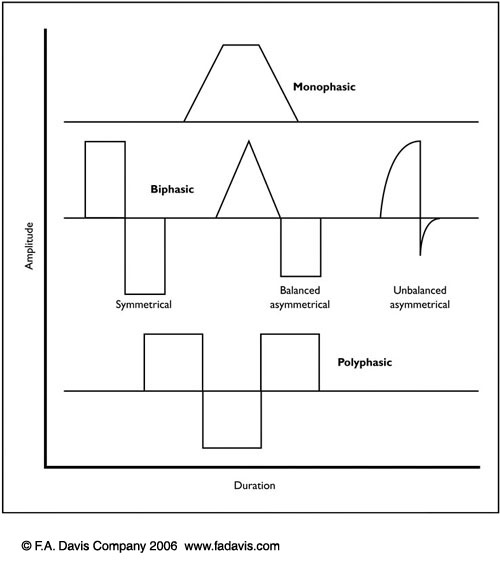
Foundations of Electrical Stimulation
PTA 101 Introduction to Clinical Practice
The following information is used for instructional purposes for students enrolled in the Physical Therapist Assistant Program at Lane Community College. It is not intended for commercial use or distribution for commercial purposes. It is not intended to serve as or take the place of medial advice or treatment.
Contact thorpeb@lanecc.edu for permission
Electrical stimulation use dates back to ancient time when electric eels were used to treat painful spines and limbs. In this lesson, we will study the characteristics of electricity and its use in rehabilitation. By understanding how different wave forms effect muscle and nerve function, we can safely and effectively select a variety of electrical stimulation options to maximize patient progress toward goals in the plan of care.
After completing this lesson, the successful student will be able to:
There are several Types of Electrical Stimulation covered in Behrens text:
|
Type of Electrical Stimulation |
Goal |
|
Electrical Muscle Stimulation (EMS) |
stimulation of denervated muscle to maintain viability |
|
Electrical Stimulation for Tissue Repair (ESTR) |
stimulation for edema reduction, increased circulation, and wound management |
|
Neuromuscular Electrical Stimulation (NMES) |
stimulation of innervated muscle to restore function including muscle strength, reduction of spasm/spasticity, prevention of atrophy, increase ROM, and muscle reeducation |
|
Functional Electrical Stimulation (FES) |
neural implantation for long term muscle activation to perform functional activities |
|
Transcutaneus Electrical Nerve Stimulation (TENS) |
portable, superficial stimulation across the skin for pain management |
To safely and effectively apply electrical stimulation to the human body, it is importance to understand the characteristics of electricity and current flow.
Key Terms: Charge = Strength
Current = Rate of Flow
Voltage = Driving Force
Resistance or Impendence = opposition
Law defines the relationship between electrical current, voltage, and resistance. Current = Voltage/Resistance

Biological tissues such as nerve and muscle membrane have the ability to simultaneously store and electric charge and oppose change in current flow. This characteristic is called capacitance. Skin and adipose act as resistors, or oppose current slow. Current always takes the "path of least resistance" when faced with multiple resistors.
Current will flow under 2 conditions:
Ionic Flow occurs in the body because like charges REPEL and opposite charges ATTRACT.

Anode = positive (+) electrode
Anion = negative (-) ion
Cathode = negative (-) electrode, often referred to as"active" electrode
Cation = positive (+) ion
Note the names are paired by attraction
At rest, a nerve holds a positive charge on the inside and negative on the outside.

Chemical reactions that occur under each electrode (Brethren Figures 8-2 and 8-3)
Cathode: positive Nan+ sodium ions migrate to the negative pole and combine with water to form Nao sodium hydroxide Base = increased alkalinity, promotes liquification of protein, and tissue softening
Anode: negative chlorine (Cl-) ions migrate to the positive pole and combine with water to form hydrochloric acid (HCL) = increased acidity, promotes coagulation of protein, and hardening of tissues.
Circulation improves as the body attempts to balance back to homeostasis and neutral pH level.
Impedance, or resistance to current flow, and conductivity is influenced by:
Impedance should be minimized as much as possible in order to use the lowest intensity for patient comfort. Impendence can be reduced by:
Constant Current vs. Constant Voltage Stimulator
Constant Current Stimulators produce a contant current independent of resistance encountered. The voltage adjusts to maintain constant current flow. The advantage of this type of of stimulator is to ensure a consistency physiologic response during the treatment. The negative is potential pain when the voltage increases to overcome resistance.
Constant Voltage Stimulators, conversely, produce a constant voltage. The current adjusts to depending on changes in resistance. This unit is advantageous in preventing discomfort with changes in resistance, such as an electrode losing full contact, but quality of response can be decreased with these automatic resistance changes.
There are three basic waveforms used in commercial therapeutic electrical stimulation units: direct current, alternating current, and pulsed current.
According to the Behrens text, "Waveform is a visual representation of the pulse. Waveforms are diagrammatic only and rarely reflect what is actually going into the patient."
Classification of Waveforms

Waveform Comfort
Waveform Selection
It is important to know the vocabulary listing in the and goal of these levels.
|
Behrens Table 8-3 |
Clinical Levels of Stimulation |
|
Subsensory |
No nerve fiber activation No sensory awareness |
|
Sensory |
Tingling, prickling, or pins and needles Cutaneous A-beta nerve fiber activation |
|
Motor |
Strong paresthesias Muscle contraction A-alpha nerve fiber activation |
|
Noxious |
Strong, uncomfortable paresthesias Strong muscle contraction Sharp or burning pain sensation A-delta and C-fiber activation |
Frequency - number of electrical pulses delivered to the body in one second
Duty Cycle - ratio of on time to off time

Ramp Time - gradual increase in amplitude over time from zero to peak amplitude.
Accommodation - nerve cell will not generate an action potential after a period of time, no longer responding to electrical current, without an increase in intensity. Modulation, or varying one or more parameter, can prevent adaptation to the stimulus.
Below is a table view of the difference between a contraction elicited through normal central nervous system function as compared that via use of electrical stimulation means.
|
Motor Unit Recruitment - Central Nervous System |
Motor Unit Recruitment and Contraction - Electrical Stimulation |
|
Active |
Passive |
|
Small type I motor units are recruited first then larger type II motor units for smooth and gradual tension |
Large superficial fatigable type II motor units are recruited first, then smaller motor units |
|
Asynchronous firing in off and on pattern - energy efficient and slower onset of fatigue |
Synchronous firing - motor units stimulated continue to fire until stimulus removed, causing quick onset of fatigue |
|
Action potential moved away from the nerve cell body |
Action potential generated in two directions, away from the cell body and back toward the cell body |
There are times clinically when a Physical Therapist may decide to use a modality that is normally contraindicated after discussion with the patient's physician. For example, a patient with a history of cancer in the distant past or application of the modality at an extremity away from the cancer site may not pose more risk than benefit.
Procedure, Safety, and Documentation for electrical stimulation will be covered in lab
There are many choices of electrode shape, size, and configuration to fit the need of the patient and therapeutic goal for electrical stimulation.
Carbon - Impregnated Rubber Electrodes - degrade over time and become non-uniform with "hot spots", many shapes and sizes, rinse and dry after each use and replaced every 12 months to ensure conductivity.
Self-Adhering or Single use Electrodes - flexible conductors, convenient application, no strapping or taping to keep in place, resealable bag for multiple uses, often high impendence, possibility of cross-contamination, used most frequently these days.
Electrode Size and Current Density
Completing the Circuit - an electrical stimulation treatment must include a full circuit. To complete the circuit, there must be:
Table 9-1 Channel Set Up and Lead Management
|
Treatment Goal |
# Leads and Electrodes |
Monopolar |
Bipolar |
Quadpolar |
|
Muscle (motor) Stimulation |
One lead per muscle with both electrodes on the same muscle, two leads if it Is a larger muscle or if the device has more than one head |
|
X |
|
|
Sensory Stimulation |
One or two leads depending on the size of the area; use as many electrodes as possible to sensory stimulation
One lead if only one lead and two electrodes fit in the treatment area
One lead with one electrode at the spinal nerve root and the other in the sensory area |
X |
X |
X
|
|
Delivery of Medication |
One lead and one electrode in the treatment area and the other more proximally placed on soft tissue |
X |
|
|
Table 9-2 in the Behrens text had information regarding Potential Causes and Remedies for Patient Complaints of Prickling and itching Sensation Underneath the Electrodes.
Terminology for Configuration of Electrode Set Up
Monopolar - single electrode from one channel
Application Guidelines - this will be covered in depth in lab, along with the Electrical Stimulation Decision Making Tree on page 159 in your Behren's text.
The PTA is given a Physical Therapy evaluation with patient medical history, diagnosis, goals, and plan of care (POC). Often, simply 'modalities' or 'electrical stimulation' is listed but no specific treatment parameters. Based on this information and subjective information gathered from the patient at the time of treatment, the PTA determines the most appropriate modality and parameters for that specific treatment as it falls within the POC. Patient response to treatment is always monitored and reported back to the PT. It is the responsibility of the PTA to make modifications within the plan of care and consult with the PT as needed. Since there is an object or substance being applied to the body, remember skin checks before and after application of any modality.
Communication with the patient is crucial, including informed consent, and checking for changes in the patient's medical history since the last visit. There may have been a medical test, appointment with a physician, or changes in physician's orders since the previous therapy appointment. The PTA must decide if and how the changes may affect the impending treatment and communicate with appropriate staff.
.






Consider using the "Why Do I Need to Know About..." and "Patient Perspective" boxes in your textbook to understand the concepts presented. Discussion questions and Case Studies are a great way to check your level of understanding. Use the CAN YOU HELP ME forum to share your thoughts with classmates.